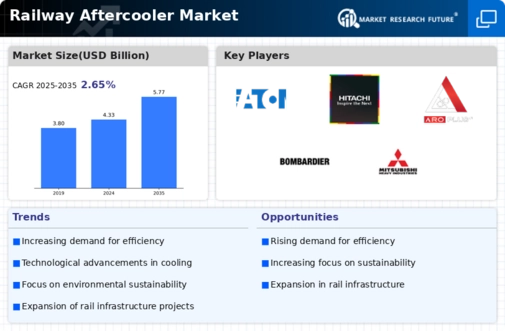Rising Focus on Energy Efficiency
The Railway Aftercooler Market is increasingly influenced by a rising focus on energy efficiency. As energy costs continue to escalate, railway operators are prioritizing technologies that enhance fuel efficiency and reduce operational costs. Aftercoolers play a pivotal role in this endeavor by ensuring that engines operate at optimal temperatures, thereby improving fuel consumption rates. The market is likely to expand as more operators recognize the long-term cost savings associated with investing in high-performance aftercooling systems. Additionally, the growing awareness of the environmental impact of energy consumption is prompting rail companies to adopt more sustainable practices, further driving the demand for efficient aftercoolers.
Growing Investment in Railway Infrastructure
The Railway Aftercooler Market is poised for growth due to increasing investments in railway infrastructure. Governments and private entities are allocating substantial funds to modernize rail networks, which includes upgrading locomotive systems. This investment trend is expected to boost the demand for aftercoolers, as new locomotives require advanced cooling solutions to operate efficiently. For example, recent reports indicate that several countries are planning to invest billions in railway upgrades over the next decade, which will likely include the integration of state-of-the-art aftercooling systems. This influx of capital not only enhances the operational capabilities of rail systems but also supports the overall growth of the aftercooler market.
Increased Demand for Efficient Cooling Systems
The Railway Aftercooler Market is experiencing a surge in demand for efficient cooling systems, driven by the need for enhanced performance in locomotives. As rail operators seek to optimize fuel efficiency and reduce emissions, aftercoolers play a crucial role in maintaining optimal engine temperatures. The market is projected to grow at a compound annual growth rate of approximately 5% over the next five years, reflecting the increasing emphasis on operational efficiency. Furthermore, advancements in aftercooler technology, such as improved heat exchange materials, are likely to contribute to this growth. This trend indicates a shift towards more sustainable practices within the railway sector, as companies aim to meet stringent environmental regulations while maximizing performance.
Technological Innovations in Aftercooler Design
The Railway Aftercooler Market is benefiting from ongoing technological innovations in aftercooler design. Manufacturers are increasingly focusing on developing lightweight, compact, and highly efficient aftercoolers that can withstand the rigors of railway operations. Innovations such as enhanced heat transfer materials and modular designs are becoming more prevalent, allowing for easier installation and maintenance. This trend is likely to attract more railway operators to invest in modern aftercooling solutions, as they seek to improve the reliability and efficiency of their locomotives. Furthermore, the integration of smart technologies, such as sensors for real-time monitoring, is expected to enhance the performance of aftercoolers, thereby driving market growth.
Regulatory Compliance and Environmental Standards
The Railway Aftercooler Market is significantly influenced by stringent regulatory compliance and environmental standards. Governments worldwide are implementing stricter emissions regulations, compelling railway operators to adopt technologies that minimize environmental impact. Aftercoolers are essential in this context, as they help reduce exhaust temperatures and improve overall engine efficiency. The market is expected to witness a notable increase in demand as operators strive to meet these regulations. For instance, the introduction of the European Union's stringent emissions standards has prompted many rail companies to invest in advanced aftercooling solutions. This regulatory landscape not only drives innovation but also fosters a competitive environment where companies are incentivized to enhance their cooling technologies.
















Leave a Comment